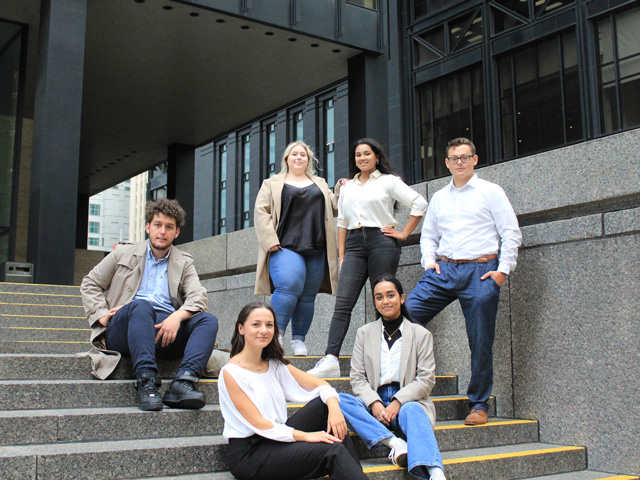Expanding horizons at Ryerson’s first Canadian Undergraduate Physics Conference

From left to right: Donald Kondi, Helen Melino, Melanie Sanginesi, Neha Nasir, Jasleen Banga and Gustavo Cicchini Santos
This past fall marked the first time in its 57-year history that the Canadian Undergraduate Physics Conference (CUPC) (external link) was hosted by Ryerson University. Executed solely by undergraduate students and designed to bring together delegates from across Canada to engage, network and share knowledge about physics, including potential career paths, this year’s CUPC expanded its mandate of uniting undergraduate students with academic leaders and industry professionals. High school students were also invited to attend keynote lectures, workshops, networking opportunities and student presentations.
“High school students have never been invited to attend this conference before,” says third-year medical physics student and conference co-chair Neha Nasir. “We wanted to expose them to the undergraduate experience and showcase the expansive possibilities of a physics degree. There’s more to the field than an academic career. We wanted to demystify physics and also broaden the diversity of students in this area. One way to do that is to generate interest in secondary students from various backgrounds, and especially those who belong to historically marginalized groups.”
Co-chair Helen Melino, also a medical physics student, emphasizes that it’s important to move beyond the physicist stereotype: white, male, esoteric and hard to understand. Because there’s some truth in this typecasting, as supported by the recent EDI in Physics survey conducted by the Canadian Association of Physics (CAP) (external link) , the two leaders added sessions on science communication and the perception of physics to spark important conversations early on in students’ undergraduate careers.
“One of our sessions focused on accessible and inclusive practices when creating and sharing scientific content,” says Melino. “It’s important for scientists to know how to communicate to non-experts outside the scientific community. We wanted to help remove some of the barriers between scientists and the general population. That fit our overall theme of building a more diverse, inclusive and accessible field, whether through university recruitment practices, promoting varied career opportunities, or being intentional about communication.”
The conference also offered a land acknowledgment session focused on fostering ethical relationships with the Indigenous Peoples and lands, exploring the importance of providing deeply reflective and actionable land acknowledgments which pertain specifically to individual researchers. Attendees considered the ways in which land acknowledgments can become educational pathways into understanding the significance of Canada’s history and ongoing presence as a colonial state.
Overall, Nasir and Melino were pleased with how the conference brought together a wide range of students and experts from across Canada to build relationships, broaden perspectives, foster community and, they hope, inspire young people from equity groups to explore the possibilities offered by a physics degree.
In addition to their professional development, the co-chairs also enjoyed making new friends and feeling more connected to young physicists from other universities.
“It feels a bit surreal to be on the other side of the conference, after working on it for a year,” says Nasir. “In addition to making those new connections, we’ve seen our team grow in confidence as students and as event organizers.”
There is still some follow-up work for the co-chairs: providing a report of the conference to the CAP and collecting feedback from the attendees. They also have funds to donate to IndigeSTEAM (external link) , a non-profit whose mission is to provide Indigenous-led and culturally-relevant programming in STEM/STEAM to support a better future for Indigenous youth.
“We still have a to-do list to wrap-up CUPC 2021,” says Melino. “But we are excited to pass on the knowledge that we have gained from this experience to the next organizers!”